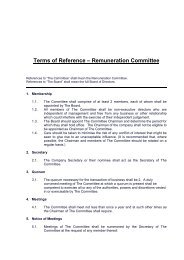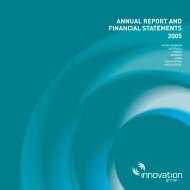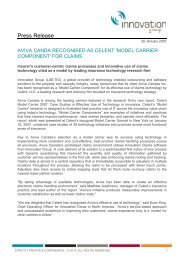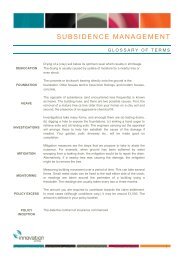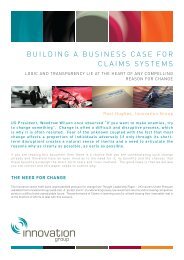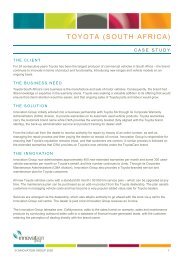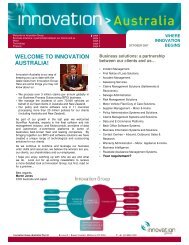Tipping Point Innovation and Transformation Final - Innovation Group
Tipping Point Innovation and Transformation Final - Innovation Group
Tipping Point Innovation and Transformation Final - Innovation Group
Create successful ePaper yourself
Turn your PDF publications into a flip-book with our unique Google optimized e-Paper software.
T I P P I N G P O I N T … I N N O V A T I O N A N D T R A N S F O R M A T I O N<br />
Malcolm Gladwell’s book “The <strong>Tipping</strong> <strong>Point</strong>”, suggests a tipping point is when an idea, trend, behavior or expectation<br />
crosses a threshold <strong>and</strong> spreads like wildfire. It can change the fundamentals of business <strong>and</strong> be sudden.<br />
History has seen many tipping points. They offered opportunities to use technology, creating innovation <strong>and</strong><br />
transformation. Another “tipping point” is underway.<br />
Carlota Perez, a scholar of technology <strong>and</strong> socio-economic development at Cambridge University, believes from the<br />
Industrial Revolution to the Information Age, there is a consistent pattern in the diffusion of technological revolutions <strong>and</strong><br />
their impact on macro-economic trends. Growth in the economy takes place by successive surges of about half a<br />
century, each driven by a technological revolution. Her analysis of these patterns of revolution, innovation <strong>and</strong><br />
transformation are shown below.<br />
Installation<br />
Industrial<br />
Revolution<br />
1771<br />
Steam &<br />
Railways<br />
1829<br />
Steel, Electricity &<br />
Heavy Engineering<br />
1875<br />
Automobiles, Oil &<br />
Mass Production<br />
1908<br />
Information &<br />
Telecommunications<br />
1971<br />
Collapse &<br />
Readjustment<br />
CANAL PANIC<br />
1797<br />
(Britain)<br />
RAILWAY PANIC 1847<br />
(Britain)<br />
GLOBAL COLLAPSES<br />
OF THE 1890s<br />
(Argentina, Australia, U.S.)<br />
GREAT CRASH<br />
OF 1929<br />
(U.S.)<br />
NASDAQ CRASH OF 2000<br />
& GLOBAL COLLAPSES<br />
(Asia, Argentina, U.S.)<br />
Deployment<br />
• Diffusion of manufacturing with water power<br />
• Full network of waterways (canals, rivers, oceans)<br />
• Development of public companies<br />
• Economies of scale<br />
• Joint stock companies<br />
• Repeal of tariff laws/free trade<br />
• Transcontinental rail, steamships <strong>and</strong> telegraph<br />
• Gold st<strong>and</strong>ard, global finance<br />
• Interstate/international highways <strong>and</strong> airways<br />
• Welfare state, Bretton Woods, IMF, World Bank<br />
• Global, digital telecommunications network<br />
• Institutional framework facilitating globalization<br />
Based on Technological Revolutions <strong>and</strong> Financial Capital:<br />
The Dynamics of Bubbles <strong>and</strong> Golden Ages, Carlota Perez<br />
Ms Perez suggests core radical innovations come first, spawning a wave of interrelated investment. Each such<br />
revolution takes about half a century to spread around the world, <strong>and</strong> is characterized by the two distinct periods:<br />
installation <strong>and</strong> deployment.<br />
The Installation Period lasts years but ends in a speculative financial boom or bubble. It is a time of creative destruction<br />
with the emergence of new technologies into the marketplace, new businesses using these technologies, <strong>and</strong> new<br />
business models.<br />
The bubble collapse leads to a correction. The Deployment Period follows, weaving technology into the fabric of business<br />
<strong>and</strong> society. The deployment period is a time of creative construction <strong>and</strong> institutional re- composition. The new<br />
technologies <strong>and</strong> business paradigms become the norm <strong>and</strong> drive long-term growth <strong>and</strong> expansion of these successful<br />
business models.<br />
Over the past couple of centuries years, we have had a technology revolution every 40 - 60 years, starting with the<br />
Industrial Revolution in 1171; followed by the age of steam <strong>and</strong> coal, iron <strong>and</strong> railways which started in 1829; then steel<br />
<strong>and</strong> heavy engineering (electrical, chemical, civil <strong>and</strong> naval) in 1875; <strong>and</strong> then the automobile in 1908. The current era,<br />
the information technology <strong>and</strong> telecommunications age, started in 1971 represents the fifth major revolution during this<br />
200+ year span.<br />
July 2010 www.innovation-group.com 2 of 8





